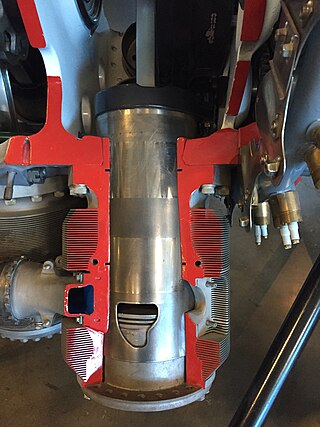
The sleeve valve is a type of valve mechanism for piston engines, distinct from the usual poppet valve. Sleeve valve engines saw use in a number of pre–World War II luxury cars and in the United States in the Willys-Knight car and light truck. They subsequently fell from use due to advances in poppet-valve technology, including sodium cooling, and the Knight system double sleeve engine's tendency to burn a lot of lubricating oil or to seize due to lack of it. The Scottish Argyll company used its own, much simpler and more efficient, single sleeve system (Burt-McCollum) in its cars, a system which, after extensive development, saw substantial use in British aircraft engines of the 1940s, such as the Napier Sabre, Bristol Hercules, Centaurus, and the promising but never mass-produced Rolls-Royce Crecy, only to be supplanted by the jet engines.

The Overland Automobile Company was an American automobile manufacturer in Toledo, Ohio. It was the founding company of Willys-Overland and one of the earliest mass producers of automobiles.

Kaiser Motors Corporation made automobiles at Willow Run, Michigan, United States, from 1945 until 1953. In 1953, Kaiser merged with Willys-Overland to form Willys Motors Incorporated, moving its production operations to the Willys plant at Toledo, Ohio, where the company continued to build automobiles under the Kaiser marque including the Kaiser Darrin until 1955. Their South American operations continued to build passenger cars well up into the 1960s. The company changed its name to Kaiser Jeep Corporation in 1963.

Panhard was a French motor vehicle manufacturer that began as one of the first makers of automobiles. It was a manufacturer of light tactical and military vehicles. Its final incarnation, now owned by Renault Trucks Defense, was formed by the acquisition of Panhard by Auverland in 2005, and then by Renault in 2012. In 2018 Renault Trucks Defense, ACMAT and Panhard combined under a single brand, Arquus.

The Jeepster is an automobile originally produced by Willys-Overland Motors from 1948 until 1950. It was developed to fill a gap in the company's product line, crossing over from their "utilitarian" proto SUVs and trucks to the passenger automobile market.
The Willys Aero was a line of passenger cars manufactured first by Willys-Overland and later by Kaiser-Willys Corporation from 1952 through 1955 in the United States of America. It was also produced in Brazil from 1960 to 1971.

Willys Overland Crossley was a company jointly owned by Crossley Motors and Willys-Overland. They had factories in Stockport, England; Berlin, Germany; and Antwerp, Belgium. The company was formed in 1919 and continued until 1934. They manufactured cars, buses and trucks.

John North Willys was an American automotive pioneer and diplomat. His company, Willys-Overland Motors, became the second largest carmaker in the United States after Henry Ford.

F. B. Stearns and Company, later known as F. B. Stearns Company was an American manufacturer of luxury cars in Cleveland, Ohio marketed under the brand names Stearns from 1900 to 1911 then Stearns-Knight from 1911 until 1929.

The Knight engine is an internal combustion engine, designed by American Charles Yale Knight (1868-1940), that uses sleeve valves instead of the more common poppet valve construction.

The Henry J is an American automobile built by the Kaiser-Frazer Corporation and named after its chairman, Henry J. Kaiser. Production of six-cylinder models began in their Willow Run factory in Michigan in July 1950, and four-cylinder production started shortly after Labor Day, 1950. The official public introduction was on September 28, 1950, and the car was marketed until 1954.

Studebaker-Garford was an automobile produced and distributed jointly by the Garford Company of Elyria, Ohio, and the Studebaker Corporation of South Bend, Indiana, from 1904 through 1911. During its production, the car was sold as a Studebaker, per the marketing agreement between the two firms, but Studebaker collectors break the vehicles out under the Studebaker-Garford name because of the extent of Garford components.

The Marion was an automobile produced by the Marion Motor Car Company in Indianapolis, Indiana from 1904 to 1915.

The Moline Automobile Company, was an American brass era automobile manufacturer in East Moline, Illinois known for the Moline, Dreadnought Moline,Moline-Knight and R & V Knight marques.

The Russell Motor Car Company was an automobile manufacturer in Toronto, Canada, that produced cars from 1904 to 1916. The company is considered to have produced Canada's first successful automobile.

Falcon-Knight was a brand of automobile produced between 1927 and 1928 by the Willys-Overland Company of Toledo, Ohio. A separate company, the Falcon Motor Corporation was registered with headquarters in Detroit, Michigan. The cars were built in a former Garford Truck plant in Elyria, Ohio. The automobiles were well received with "a remarkable reputation for all-around performance and the sales were notably high."

Willys was a brand name used by Willys–Overland Motors, an American automobile company, founded by John North Willys. It was best known for its design and production of World War II–era military jeeps (MBs), Willys M38 and M38A1 military jeeps as well as civilian versions, and branding the 'jeep' military slang-word into the '(Universal) Jeep' marque.
The Lyons-Knight was an American automobile manufactured from 1913 until 1915 in Indianapolis, Indiana.

Sizaire Frères was a French automobile manufacturer established by the brothers Maurice (1877–1970) and Georges Sizaire (1880–1924) in 1920, and producing cars between 1923 and 1929.

Charles Yale Knight was an entrepreneur and inventor of the sleeve valve technology. His Knight engines would be used in the early cars, British tanks, and British aircraft. Customers included Henry Ford's competitor, John Willys and his company, Willys–Overland Motors, second largest car manufacturer after Ford Motor, as well as by Daimler, Mercedes, Peugeot and others. He was a millionaire by the time he was 44 years of age, in 1912.
























